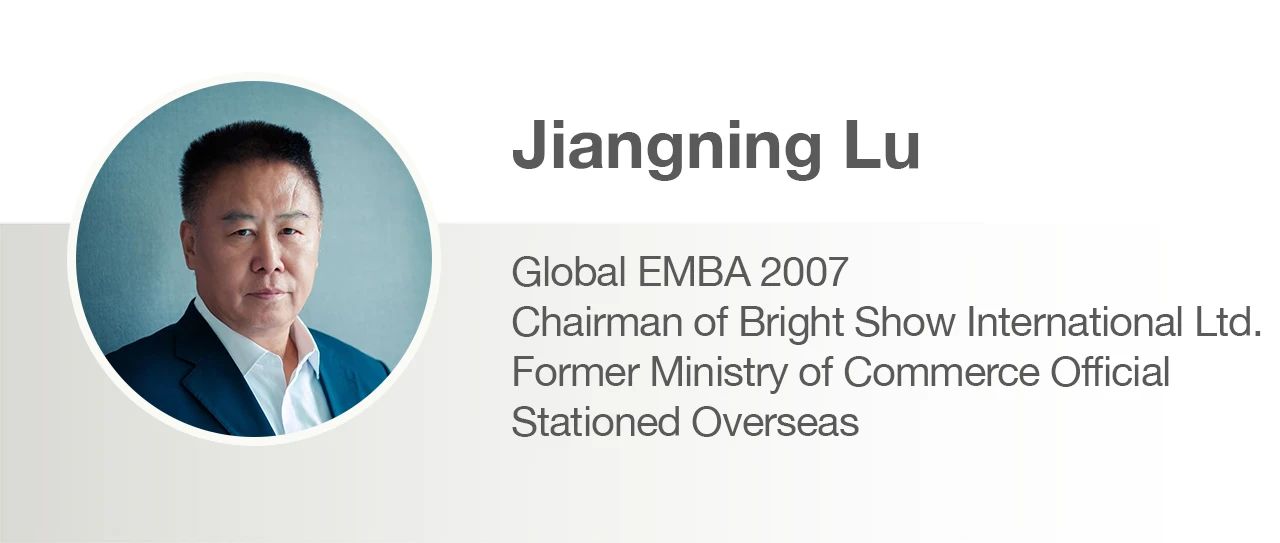How can Chinese Enterprises Navigate the Ongoing Tariff War?

In a shocking series of escalations, last week saw the US government unleash a 145% punitive rate against China. This is, however, only the latest step in a long-brewing war of words and economic tension that began in 2018 during Donald Trump’s first administration, if not before. The current Trump administration's tariff policies are strategically targeted, not only trapping export-focused Chinese enterprises in a dilemma but also intensifying the urgency for China to upgrade its industrial capabilities and self-reliance.
In this article, Lu Jiangning (CEIBS GEMBA 2007), Chairman of Bright Show International Ltd. and a former Ministry of Commerce official posted overseas, provides a detailed analysis of the impact of US tariff increases and the adaptive strategies that Chinese enterprises may adopt.

01 Foreign Trade Bears the Brunt
The US-China trade war has now entered a new phase, with tariffs imposed by the Trump administration on Chinese goods totaling 145% at the time of writing. This high-tariff policy will deal a severe blow to China's competitiveness in exports. Unlike earlier, lower tariffs, the current levy exceeds enterprises' capacity to absorb costs through price adjustments or currency fluctuations, directly undermining China's core advantages in terms of exports to the US.
America’s actions are strategically targeted, and are accompanied by accusations currency manipulation and overcapacity - issues that strike at the heart of China's economic strategy. By targeting China’s foreign trade, a critical engine of the country’s overall GDP growth, the US aims to destabilise China’s overall economic development.. This targeted strategy reflects a deep understanding of China's economic structure.
As early as 2025, when Trump first signaled domestic tax hikes, my company Wanxiu International began preparing contingency plans. We implemented price adjustments immediately after the Spring Festival, but the tariffs announced by President Trump nevertheless exceeded our expectations. Looking back, our early preparations were vital in serving as a buffer, buying us time to adjust to the new economic reality.
After the Trump administration imposed additional tariffs, my company felt immediate, multidimensional shocks. Our three core business metrics - order volume, profit margin, and client relationships - all declined simultaneously. Since the Spring Festival, we've been forced to raise prices to offset rising costs; client acceptance and understanding of this necessity has needless to say been limited.
Our price adjustments unfolded in two phases. First, a flat 20% increase initially resisted by most of our customers. ,; In the second phase, we ultimately had to raise prices by 40%. This directly reduced our year-on-year orders by 20%. Even our long-term clients are now exploring the viability of securing new suppliers in Vietnam and Thailand, signaling a clear shift away from China.
Currently, we face pressure on three fronts: a roughly 35% increase in overall costs due to rising raw material prices and tariffs; a 15% profit squeeze; and a strain on client relationships. It is noticeable that some of our decade-long partners suddenly demanded a renegotiation of their contracts, asking us to absorb tariff costs under risk of them suspending orders - a painful " divorce".
If international trade were a marriage, and now the US has unilaterally filed for separation. We "divorced" enterprises must, consequently, find a new way out. Some pivot towards Vietnam, others target the Middle East, but all face painful transitions. Our next steps include diversifying trade to reduce reliance on traditional markets and promoting deeper strategic partnerships with foreign firms.

02 The Trade War is Just Beginning
While China is being targeted most heavily, it is important to remember that the US tariff policies weren’t initially limited to any single nation; Japan, South Korea, and Europe all remain potentially in the firing line despite the 90-day tariff pause applying to a wide range of nations). This indicates a major turning point in the global trade order.
As a result, Asia’s capital markets reacted strongly, with the Shanghai Stock Exchange plunging 9% and Hong Kong market dropping 13% in a single day - making them the two worst-performing markets globally. Entrepreneurs have seen their assets shrink by hundreds of millions, underscoring the market’s deep anxiety over the escalating trade war.
In terms of direct trade, the current US-China trade imbalance (a $300 billion Chinese surplus) amplifies the impact of the tariffs. It is expected that Chinese goods in the US will surge in price, potentially leading to a 30%-40% decline in American consumer demand. Even more noteworthy are the indirect impacts on trade. Although Chinese enterprises have expanded their footprint in regions like Southeast Asia and Mexico, creating a trade model that could be called “Made in a ‘third country’, but essentially Made in China”, total US-China trade volume still amounts to as much as $700 billion.
Foreign trade is currently China's sole robust growth driver among the “three pillars” of China’s economy (the other two being investment and consumption). With slowing investment growth and weak domestic consumption, any sharp decline in foreign trade could trigger a chain reaction affecting employment, tax revenue, and more. Given the asymmetry in trade volume between China and the US (China imports only $140 billion worth of American goods), more systemic solutions beyond reciprocal tariffs are needed.
In a prolonged trade war, viable strategies for China include diversifying overseas production; upgrading domestic industries for higher value-added products; expanding emerging markets; deepening trade partnerships; and strengthening domestic consumption. A drawn out trade war will test China's economic resilience and adaptability to the limit.
While multiple challenges loom, breakout paths do exist. China’s increasingly successful technology firms demonstrate resilience. For example, one highly innovative feed additive company with proprietary technology has still managed to increase prices and hit stock-price limits amid 50% tariffs. This underscores the importance of technological autonomy amid an uncertain trade climate. However, many OEM manufacturers will unavoidably remain trapped in low-margin, high-risk cycles.
To bypass these new and unpredictable barriers, Chinese firms must adopt multifaceted globalisation strategies. On one hand, this involves shifting their identity, for example by acquiring highly visible foreign assets or registering companies overseas to evade discrimination. On the other hand, they can replicate companies like Haier's M&A-driven localisation; alternatively, they can relocate supply chains to regions like Southeast Asia. Notably, some Southeast Asian countries like Vietnam also seem likely to face high US tariffs, making such moves futile unless zero-tariff agreements can be negotiated with the US government.
Long-term, strategic transformation is also critical, both for China as a whole and for individual Chinese enterprises. This should include reducing export dependency, developing "dual-track import-export” business models, and global asset allocation. However, simple capacity shifts are insufficient; companies must build comprehensive competitiveness across their brand identity, technology, and markets. Policymakers must encourage industrial capacity upgrades while cultivating more enterprises with core technologies, rather than relying on short-term tactics . This is a marathon, not a sprint, requiring systemic national and corporate responses.

03 Sustainable Countermeasures
External pressures from the trade war may well serve as a catalyst for economic reform in China, forcing us to face up to structural challenges in development while accelerating the process of opening up.
Looking back, external crises have historically driven breakthroughs in reform. The economic collapse of the late 1970s sparked wide-ranging reform; the 1997 Asian Financial Crisis reshaped state-owned enterprises and finance; and the 2008 Global Financial Crisis optimised China’s industrial structures.
History shows that crises catalyse progress. At this juncture, breakthroughs are needed in the following areas: institutional openness to build a high-standard open economy; market-oriented reforms to set government-market boundaries; private sector development to uphold both public ownership and encourage the development of the private economy; and innovation drives to break through bottlenecks in key technologies.
The Chinese people's ingenuity should give us cause to be confident. Chinese entrepreneurs' resilience is admirable - given proper institutional support, their creativity will continue to flourish. Now is the right moment for intelligent reform in the face of a new crisis. We must maintain strategic composure, avoid emotional responses, commit to marketisation, build consensus, and ignite innovation.
While the trade war will certainly bring pain, it also clarifies the urgency for these kinds of reform. By remaining committed to opening up and leveraging China’s collective reserves of knowledge, we can transform this pressure into momentum, achieving high-quality development and breaking free from America’s efforts at containment.

















